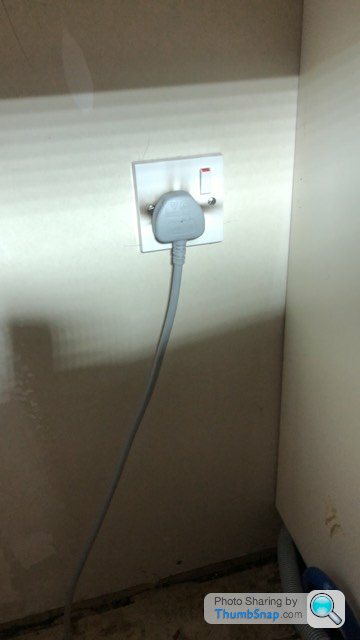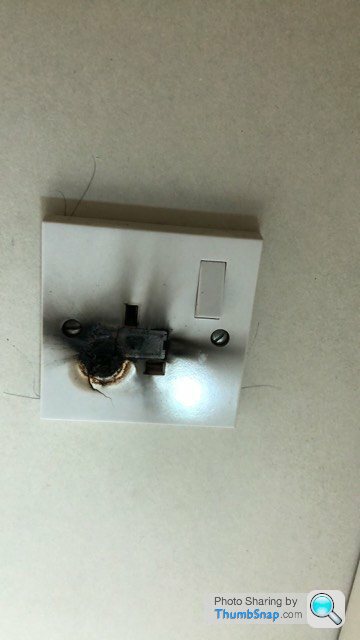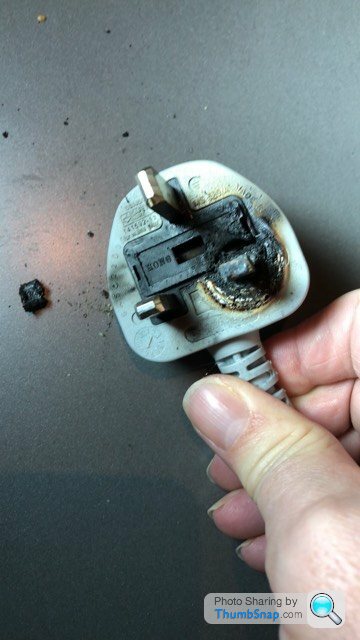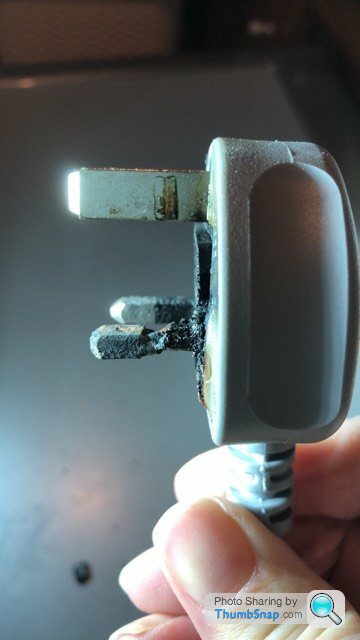Plug Melted - Potential causes?
Discussion
Has this socket ever had one of those dreadful, supposedly child-proof socket protectors put into it?
Those things are downright dangerous, partly because children certainly can remove them and then they're holding a tool that allows them to circumvent the safety shutters on the live and neutral terminals by inserting the socket protector upside-down into the earth terminal.
But the other reason they're dangerous might be relevant here: they're not manufactured to British Standards, so the plastic pins are usually marginally too big, with the effect that they wear and/or bend the contacts in the socket. When you then plug a real plug in, it's no longer making a decent contact and can arc and overheat.
Those things are downright dangerous, partly because children certainly can remove them and then they're holding a tool that allows them to circumvent the safety shutters on the live and neutral terminals by inserting the socket protector upside-down into the earth terminal.
But the other reason they're dangerous might be relevant here: they're not manufactured to British Standards, so the plastic pins are usually marginally too big, with the effect that they wear and/or bend the contacts in the socket. When you then plug a real plug in, it's no longer making a decent contact and can arc and overheat.
Obviously a bad connection, probably as someone said the pin of the plug not being tight enough in the socket, I do find it odd though that wherever there is damage like this, be it in a plug/socket, shower or cooker switch or even the mains unit, 9 times out of 10 its always the neutral that goes.
Dr Mike Oxgreen said:
Has this socket ever had one of those dreadful, supposedly child-proof socket protectors put into it?
Those things are downright dangerous, partly because children certainly can remove them and then they're holding a tool that allows them to circumvent the safety shutters on the live and neutral terminals by inserting the socket protector upside-down into the earth terminal.
But the other reason they're dangerous might be relevant here: they're not manufactured to British Standards, so the plastic pins are usually marginally too big, with the effect that they wear and/or bend the contacts in the socket. When you then plug a real plug in, it's no longer making a decent contact and can arc and overheat.
No its under the counter behind the washing machine.Those things are downright dangerous, partly because children certainly can remove them and then they're holding a tool that allows them to circumvent the safety shutters on the live and neutral terminals by inserting the socket protector upside-down into the earth terminal.
But the other reason they're dangerous might be relevant here: they're not manufactured to British Standards, so the plastic pins are usually marginally too big, with the effect that they wear and/or bend the contacts in the socket. When you then plug a real plug in, it's no longer making a decent contact and can arc and overheat.
When you replace go for a decent brand, I like Crabtree sockets and switches, they are worth the extra few £.
You could replace with a switched spur, this will do away with the plug, the cable on the washing machine needs to be long enough for you to get in behind to install it.
https://www.screwfix.com/c/electrical-lighting/swi...
If not, go for a DP 13amp socket. https://www.screwfix.com/p/crabtree-capital-13a-1-...
Make sure you use a decent quality 13a plug, I like the MK plugs as they have decent terminals.
Check the cables are not burnt, you may have to cut back a bit and re-terminate.
You could replace with a switched spur, this will do away with the plug, the cable on the washing machine needs to be long enough for you to get in behind to install it.
https://www.screwfix.com/c/electrical-lighting/swi...
If not, go for a DP 13amp socket. https://www.screwfix.com/p/crabtree-capital-13a-1-...
Make sure you use a decent quality 13a plug, I like the MK plugs as they have decent terminals.
Check the cables are not burnt, you may have to cut back a bit and re-terminate.
Looks identical to what happened to our dishwasher a few months ago. The plug had been in for 8 years, switched on permanently with no issues.... then went bang on the neutral pin. New plug on and it’s been ok since.
I just assumed it was a power surge, as the trip switch went as well?
I just assumed it was a power surge, as the trip switch went as well?
hkp57 said:
All fixed now, replaced with MK socket and plug, looks like it was a loose connection between the pin and the socket heating up over time. Remains of the neutral wire in the terminal was still tight.
Brand of the socket was Vimark which looks like a budget fitting, never seen them before.

what make was the washing machine as ours has done exactly the same ? Brand of the socket was Vimark which looks like a budget fitting, never seen them before.

Cheap sockets combined with a plug permanently attached are a recipe for a blow - it's fine if the plug is taken out and put back in again now and again, but who does that to a washing machine? Whatever rubbish they use for the contacts builds up oxidation, which makes for a bad contact (particularly in a damp environment) and leads to heat, which makes it worse, and then you find the plug or socket has melted.
Agreed, cheap nasty socket outlet.
Going by the fact that there's only a single conductor into the terminals it looks like the outlet has been wired as a spur off the ring which isn't good practice on what looks like a relatively new installation.
I'd suggest having the wiring checked !!
Going by the fact that there's only a single conductor into the terminals it looks like the outlet has been wired as a spur off the ring which isn't good practice on what looks like a relatively new installation.
I'd suggest having the wiring checked !!
Nothing wrong with having that on a spur, likely from an above counter socket right above it. Would be ideal if the rung went down to it, but not actually certainly when compared to using a cheap socket, and will not have been an issue or the cause of this.
We spec'ed Hager sockets and switches throughout our rewire, which appears to have given a reasonable quality item, as good as that of MK, at a good price.
Daniel
We spec'ed Hager sockets and switches throughout our rewire, which appears to have given a reasonable quality item, as good as that of MK, at a good price.
Daniel
dhutch said:
Nothing wrong with having that on a spur, likely from an above counter socket right above it. Would be ideal if the rung went down to it, but not actually certainly when compared to using a cheap socket, and will not have been an issue or the cause of this.
We spec'ed Hager sockets and switches throughout our rewire, which appears to have given a reasonable quality item, as good as that of MK, at a good price.
Daniel
As you correctly point out, there's nothing wrong with it, but not good practice on what appears to be a relatively new install.We spec'ed Hager sockets and switches throughout our rewire, which appears to have given a reasonable quality item, as good as that of MK, at a good price.
Daniel
The problem with a lot of these cheap sockets is the quality of the terminal screws, and this particular failure appears to be resultant of a loose neutral connection at the rear. Whilst there is the age old debate about doubling over of solid drawn conductors, any electrician in my employ would do this as a matter of course where a single conductor terminates, which again calls into question the standard of installation.
For peace of mind have the premises checked !
hkp57 said:
All fixed now, replaced with MK socket and plug, looks like it was a loose connection between the pin and the socket heating up over time. Remains of the neutral wire in the terminal was still tight.
Brand of the socket was Vimark which looks like a budget fitting, never seen them before.

Old thread buts still relevant and adding value. The current of the ring runs through the N and L terminals of the socket. So even when the plug/washing machine are not used, if there is a heavy current draw on the ring circuit (or even a radial), the current runs though those terminal.Brand of the socket was Vimark which looks like a budget fitting, never seen them before.

Connect the ring using, push fit Wago types of connectors (a few makers around), one for each of L, N and E, taking the socket off the Wago connectors. They will be in the back of the backbox, being very small. The full ring current then only runs through the Wagos, and not via the socket's terminals. Wagos make a superior connection than screw-in terminals.
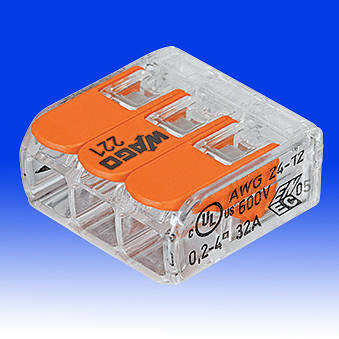
Edited by RayTay on Monday 7th June 01:53
RayTay said:
hkp57 said:
All fixed now, replaced with MK socket and plug, looks like it was a loose connection between the pin and the socket heating up over time. Remains of the neutral wire in the terminal was still tight.
Brand of the socket was Vimark which looks like a budget fitting, never seen them before.

Old thread buts still relevant and adding value. The current of the ring runs through the N and L terminals of the socket. So even when the plug/washing machine are not used, if there is a heavy current draw on the ring circuit (or even a radial), teh current runs though those terminal.Brand of the socket was Vimark which looks like a budget fitting, never seen them before.

Connect the ring using, push fit Wago types of connectors (a few makers around), one for each of L, N and E, taking the socket off the Wago connectors. They will be in the back of the backbox, being very small. The full ring current then only runs through the Wagos, and not via the socket's terminals. Wagos make a superior connection than screw-in terminals.

If the screws are loose then you could have an overloading problem where as with your method the wagos can't come loose but the socket still has screws to come loose anyway so its still a failure point in the circuit causing the same sort of damage.
Also your method would be a regs breach, wired your way it would be a ring of wagos with every socket spurred from the wagos, the regs say that you can't have more spur sockets than you have ring sockets and you wouldn't have any sockets on the ring.
Maybe a socket with wago terminals instead of screw terminals would be a good thing, like the surewire ones on lighting circuits. Certainly speed up installation methods.
Gassing Station | Homes, Gardens and DIY | Top of Page | What's New | My Stuff




